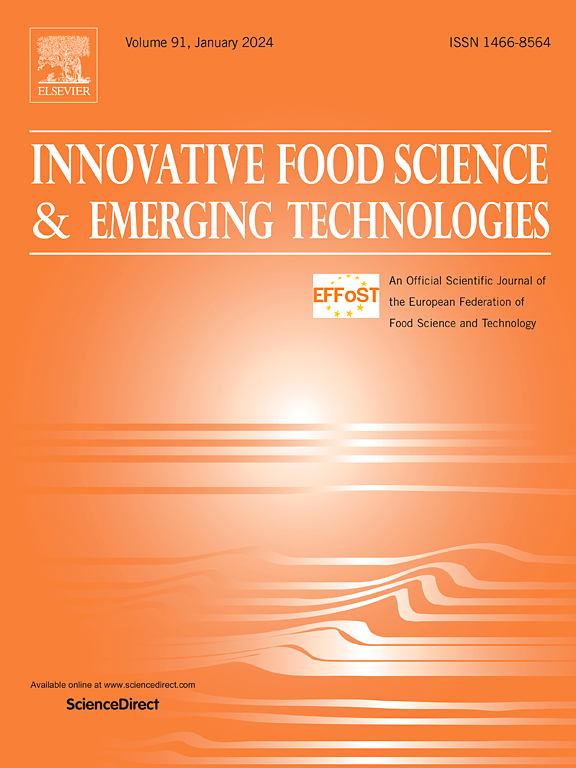微波等离子体功率对豌豆淀粉性质的影响:颗粒形态、糊化行为和凝胶性质
IF 6.3
1区 农林科学
Q1 FOOD SCIENCE & TECHNOLOGY
Innovative Food Science & Emerging Technologies
Pub Date : 2025-04-26
DOI:10.1016/j.ifset.2025.104032
引用次数: 0
摘要
微波等离子体作为一种新型的非热加工技术,以其简单、绿色、高效等优点在食品加工领域受到广泛关注。研究了MP功率(60、80和100 W)对豌豆淀粉(PS)颗粒形态、糊化行为和凝胶性能的影响。结果表明:随着MP处理功率的增大,淀粉颗粒表面产生的裂纹和孔洞增多;FTIR结果表明,MP处理后淀粉中没有产生新的官能团,但淀粉结构的无序性增加。XRD分析表明,淀粉的c型结构没有改变,但相对结晶度(RC)降低。与PS相比,MP处理后的PS溶解度(90°C, 13.26±0.73% ~ 15.93±0.89%)、溶胀力(90°C, 8.68±0.60 g/g ~ 10.26±0.23 g/g)和水解度(63.35±0.98% ~ 70.39±0.30%)均显著提高。直链淀粉含量(AM, 27.90±0.01% ~ 23.42±0.01%)、平均粒径(27.01±7.95 μm ~ 24.75±7.39 μm)和糊化温度(PT, 75.90±0.06°C ~ 73.36±0.10°C)均有所降低。当MP处理功率为80 W时,淀粉链的交联解聚最为显著,糊化行为明显。同时,适当的MP处理更容易产生低粘度、可溶性和稳定的淀粉凝胶。这些结果为PS的应用提供了一种新的改性方法,也为豌豆淀粉基产品的开发提供了理论依据。本文章由计算机程序翻译,如有差异,请以英文原文为准。

Effect of microwave plasma power on the properties of pea starch: Granule morphology, gelatinization behavior, and gel properties
As a new non-thermal processing technology, microwave plasma (MP) has attracted much attention in the field of food processing due to its advantages of simplicity, green and high efficiency. The purpose of this study was to investigate the effects of MP power (60, 80 and 100 W) on granule morphology, gelatinization behavior and gel properties of pea starch (PS). The results indicated that with the increase of MP treatment power, more cracks and holes were generated on the surface of starch particles. FTIR showed that no new functional groups were produced in PS after MP treatment, while the disorder of the starch structure increased. XRD analysis showed that the C-type pattern of starch did not change, but the relative crystallinity (RC) decreased. Compared with PS, the solubility (13.26 ± 0.73 % to 15.93 ± 0.89 %, 90 °C), swelling power (8.68 ± 0.60 g/g to 10.26 ± 0.23 g/g, 90 °C) and hydrolysis degree (63.35 ± 0.98 % to 70.39 ± 0.30 %) of PS treated with MP were significantly increased. However, the amylose content (AM, 27.90 ± 0.01 % to 23.42 ± 0.01 %), average particle size (27.01 ± 7.95 μm to 24.75 ± 7.39 μm) and gelatinization temperature (PT, 75.90 ± 0.06 °C to 73.36 ± 0.10 °C) decreased. When the MP treatment power was 80 W, the cross-linking and depolymerization of starch chains were the most significant, and the gelatinization behavior was obvious. Meanwhile, proper MP treatment made it easier to produce low-viscosity, soluble, and stable starch gels. These results provide both a new modification method for the application of PS and a theoretical basis for the development of pea starch-based products.
求助全文
通过发布文献求助,成功后即可免费获取论文全文。
去求助
来源期刊
CiteScore
12.00
自引率
6.10%
发文量
259
审稿时长
25 days
期刊介绍:
Innovative Food Science and Emerging Technologies (IFSET) aims to provide the highest quality original contributions and few, mainly upon invitation, reviews on and highly innovative developments in food science and emerging food process technologies. The significance of the results either for the science community or for industrial R&D groups must be specified. Papers submitted must be of highest scientific quality and only those advancing current scientific knowledge and understanding or with technical relevance will be considered.

 求助内容:
求助内容: 应助结果提醒方式:
应助结果提醒方式:


